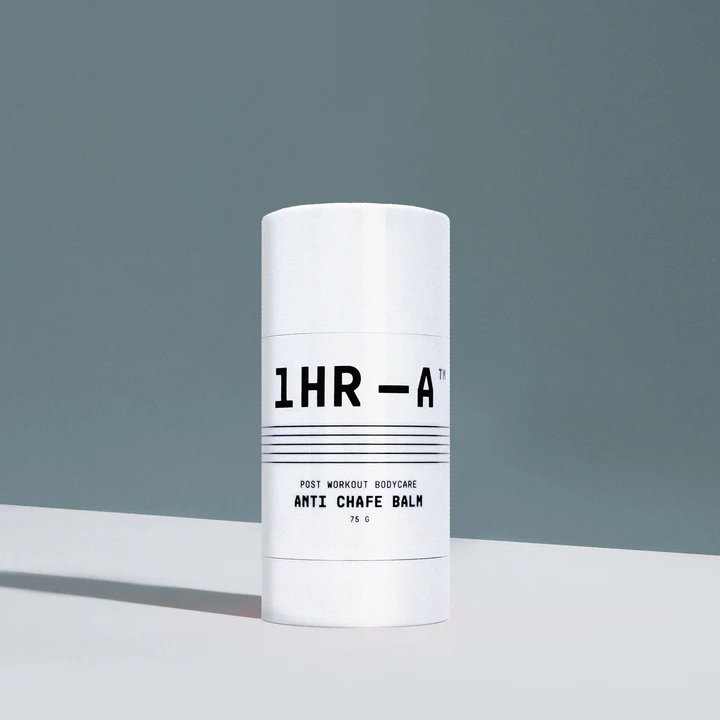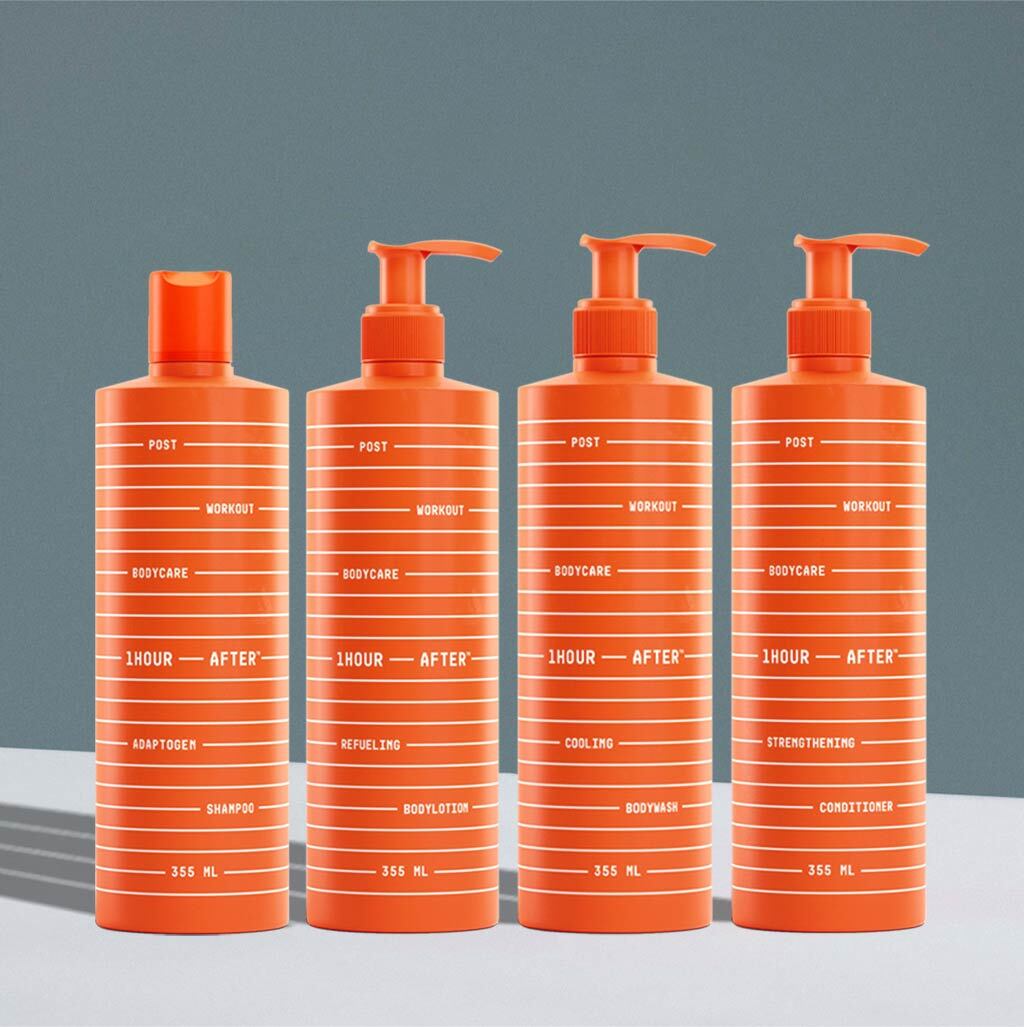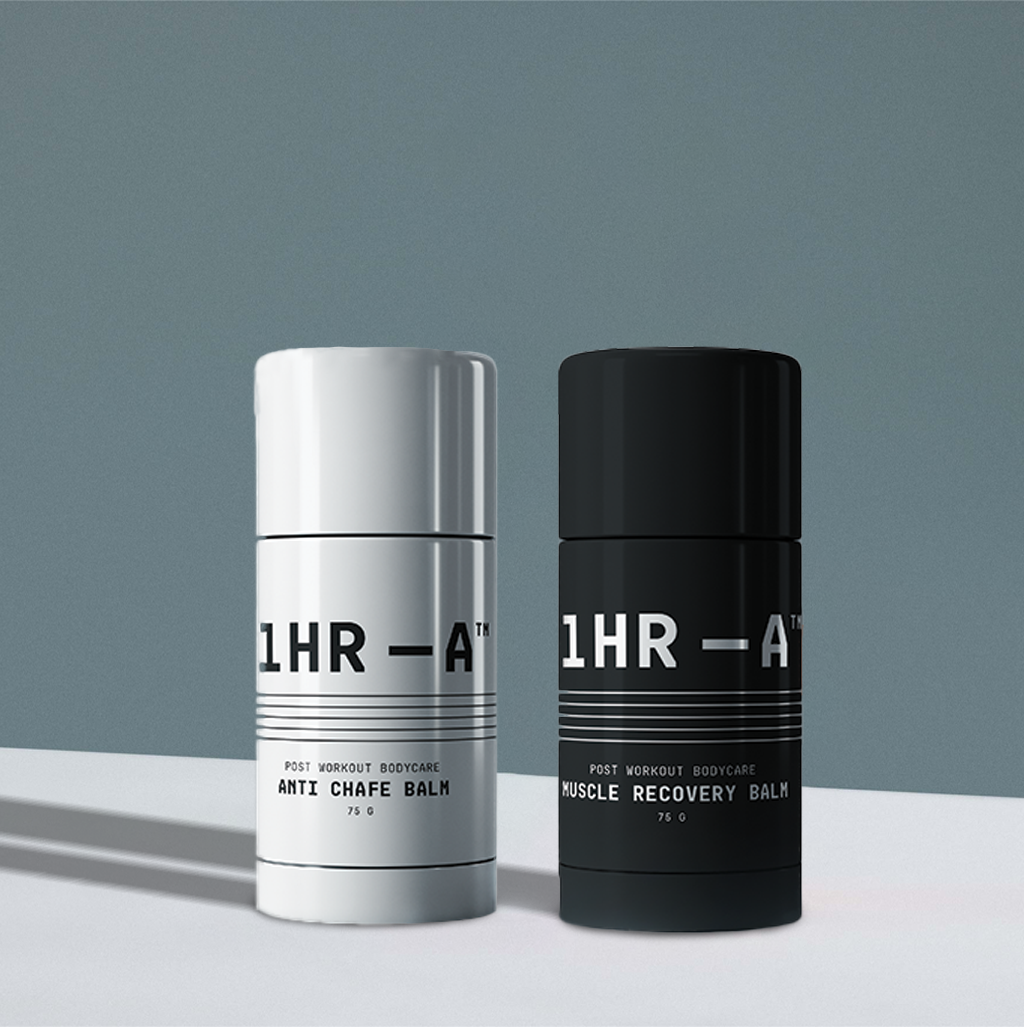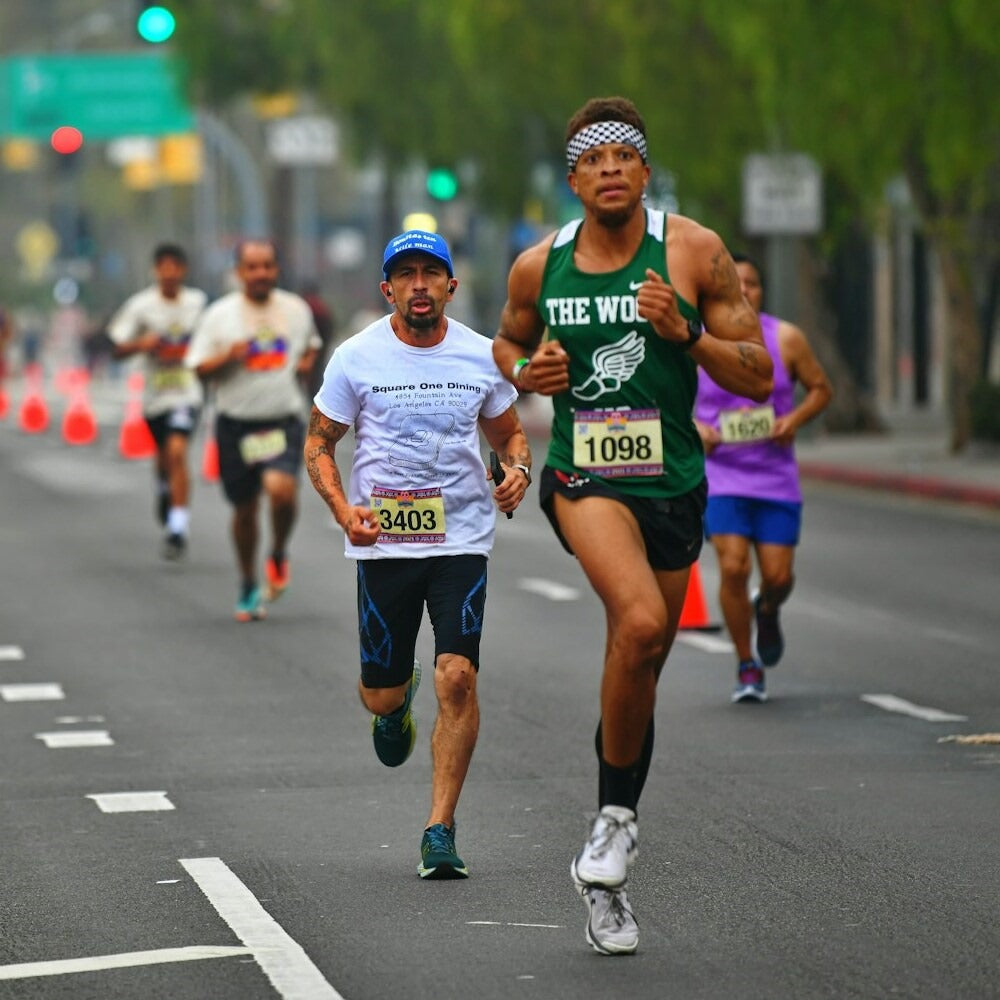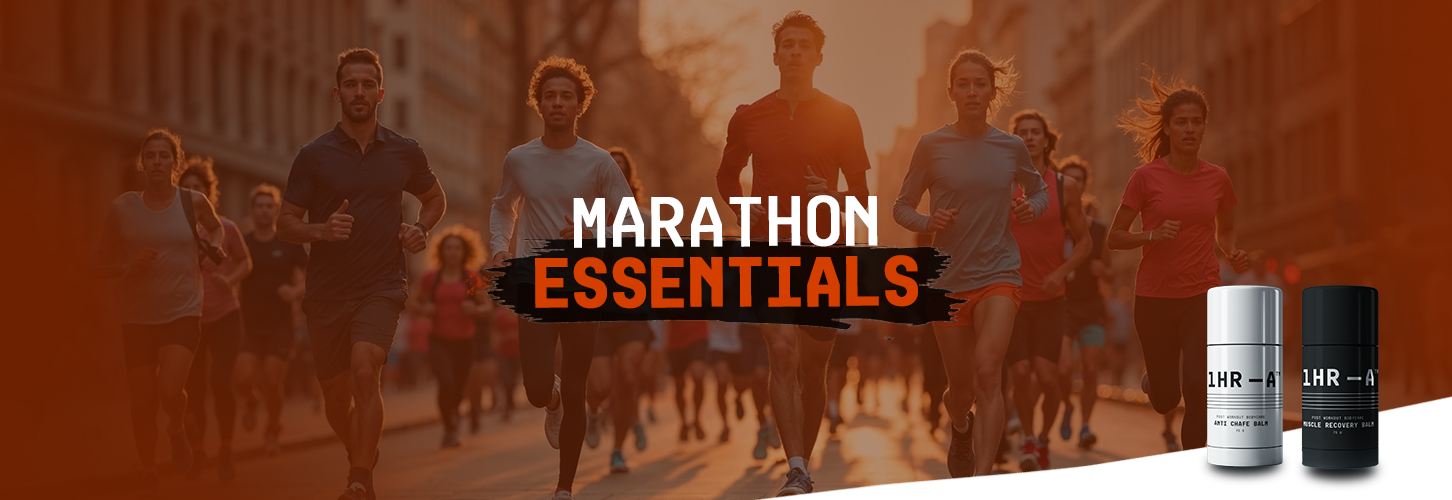
The Ultimate Marathon Gear Checklist 2025: Your Complete Guide to Race Day Success
Table of Contents
Running a marathon is a test of endurance, preparation, and strategy. While training is crucial, having the right gear and supplies can make all the difference on race day. Whether you're a first-time runner or a seasoned marathoner, this comprehensive marathon gear checklist ensures you’re fully prepared for every mile. We've got you covered, from marathon essentials to advanced recovery solutions like 1Hour After products.

Why This Marathon Gear Checklist Matters
A well-planned checklist is your roadmap to success. Studies show inadequate preparation, including missing key gear or supplies, contributes to many marathon performance issues. Research published in Sports Medicine - Open highlights that runners who fail to equip themselves properly are at a higher risk of dehydration, muscle fatigue, and injury. Furthermore, a study in PLOS Computational Biology found that over 40% of marathoners experience significant performance setbacks due to improper fueling and gear choices. Proper marathon essentials play a crucial role in the following:
- Boosting Performance: Well-fitted apparel and accessories enhance comfort and focus.
- Reduce Injury Risk: Supportive shoes and compression gear minimize strain on muscles and joints.
- Enhancing Recovery: Post-race care solutions aid in faster muscle recovery and reduce soreness.
- Minimizing Anxiety: Being fully equipped with gears and essentials helps to reduce the pre-race stress, allowing you to focus on your run.
Mental Preparation: The Often Overlooked Marathon Essential
Before focusing on physical gear, mental preparation is key. Studies suggest that mental training is a crucial component of marathon success, helping runners stay focused, manage fatigue, and maintain motivation throughout the race.
Visualization Techniques
- Course Familiarization: Study the course map, visualize running key sections, and mentally rehearse overcoming challenges.
- Performance Visualization: Picture yourself maintaining strong form, steady breathing, and a smooth pace.
- Success Scenarios: Imagine crossing the finish line, executing your hydration plan, and feeling the crowd's energy.
Race Strategy Planning
- Strategic Breakdown: Start controlled, find your rhythm, manage fatigue in later miles, and finish strong.
- Pace Strategy: Plan for different conditions, adjust for hills, and set realistic split times.
- Checkpoint Planning: Identify gear adjustments, hydration stops, and mental reset points.
Mental Tool Kit
- Mindfulness Techniques: Controlled breathing, body scan check-ins, and staying present.
- Distraction Strategies: Break the race into smaller segments, count strides, or focus on the surroundings.
- Developing Personal Mantras: To boost confidence and avoid negative thoughts before and during the race.
Turn Training Into Motivation – When the race gets tough, remind yourself of the hard work you’ve already put in: “I’ve trained through rain, heat, and exhaustion—this is just another challenge.” Trusting your preparation can help you push through fatigue and self-doubt.
-
Draw Inspiration from Others – Sometimes, the right words at the right moment can make all the difference. Reddit user rrx91 recalls slowing to a walk during the 2019 Chicago Marathon when a little old lady shouted: “SOMEDAY YOU WON’T BE ABLE TO DO THIS, BUT TODAY IS NOT THAT DAY.” That unexpected encouragement stuck with them and became a mental boost during tough moments.
- Reframe the Race as a Celebration – For Reddit user Hyperreal23, a simple message from a race announcer changed their mindset: “The hard part is over, now it’s time to celebrate those weeks of training!” That perspective shift helped ease pre-race nerves and has become their go-to mantra on race mornings.
Pre-Race Routine
- Night Before:
Spend 15 minutes visualizing race success.
Review race strategy and checkpoints.
Set positive intentions for race day.
Practice relaxation techniques.
- Race Morning:
Do a 10-minute centering meditation.
Review your mental gear checklist.
Repeat positive affirmations.
Visualize a strong and confident race start.
Intense mental preparation can be just as crucial as the right gear—helping you stay focused, push through challenging moments, and confidently cross the finish line.
Gear Selection Based on Experience Level
Choosing the right gear depends on your experience level, running goals, and personal preferences. Understanding what works best for your stage in the marathon journey ensures optimal comfort and performance.
First-Time Marathoners:
If you're running your first marathon, prioritize comfort over speed. Well-cushioned shoes help absorb impact, and moisture-wicking clothing prevents chafing during long runs. A reliable GPS watch with basic features can help you stay on pace without overcomplicating things.
Intermediate Runners:
Those with a few races under their belt may want to invest in lightweight racing shoes for better speed and efficiency. Compression gear provides muscle support and helps reduce fatigue, while advanced hydration systems make it easier to maintain energy levels throughout the race.
Elite Runners:
For those chasing podium finishes, gear choices focus on maximizing performance. Ultra-lightweight racing shoes, custom-fitted apparel, and advanced tracking devices provide every possible edge. Specialized nutrition products tailored to personal needs can also contribute to a faster, stronger race.
Before the Race: Preparation is Key
The days leading up to a marathon play a crucial role in performance. Research highlights that structured pre-race training, hydration strategies, and gear preparation are significant factors in marathon success. According to a study published in the International Journal of Exercise Science, marathon performance is closely linked to training behaviours and race-day strategies, reinforcing the importance of thorough preparation. Additionally, a review in Frontiers in Physiology emphasizes pacing, hydration, and nutrition as key contributors to endurance performance.
To ensure you're fully prepared, focus on the following key areas:
1. Gear Testing: Train in What You’ll Race In
Footwear Preparation
Your race shoes should feel like a natural extension of your feet.
Wearing untested shoes on race day can lead to discomfort or injury. Experts recommend breaking in race-day shoes at least three to four weeks prior and logging 40 to 50 miles to ensure comfort & durability and identify potential pressure points. A proper fit and lacing technique helps prevent blisters and foot fatigue.
Apparel Testing
Technical clothing plays a significant role in comfort and performance. Test all race-day apparel on training runs over two hours to ensure moisture-wicking properties are effective and seams don’t cause irritation. Experiment with different weather combinations and verify pocket accessibility for carrying essentials.
Race Day Outfit Options
- Primary Race Kit:
Moisture-wicking shirt
Comfortable running shorts/tights
Technical fabric socks
Hat or visor
- Backup Kit:
Alternative options for different weather conditions
Arm warmers or sleeves for temperature regulation
Extra pairs of socks
Hydration System Testing
If you’re using a hydration pack or belt, practice filling, cleaning, and carrying it during long runs. Calculate your fluid loss rate to determine optimal hydration intake. Test drinking while running to ensure quick, spill-free sips, and adjust the positioning for comfort.
Breathing Performance Tool
As a marathon runner, proper preparation with the breathing exerciser before your race can improve endurance, lung capacity, and overall performance.
The Prebene Breathing Exerciser is designed to help runners improve respiratory endurance by strengthening lung capacity and enhancing oxygen efficiency, ultimately boosting running performance.
How to Use: Start with lower resistance settings and gradually increase them during training sessions to develop breathing control and stamina. Consistent use can enhance lung function and endurance, preparing you for race day.
2. Skincare and Protection: Defend Against the Elements
Comprehensive Sun Protection
Applying sunscreen correctly prevents burns and discomfort.
60 Minutes Before – Apply a base layer of Neutrogena Sport Face SPF 70 to all exposed skin.
15 Minutes Before – Reapply Banana Boat Ultra Sport SPF 50, focusing on high-exposure areas.
Mid-Race Strategy – Mark designated miles for reapplication and carry a travel-size sunscreen for touch-ups.
Anti-Chafe Protection
Long races expose the body to friction. Protect high-risk areas—inner thighs, underarms, sports bra lines, foot arches, and nipples.
Primary Protection: Apply 1Hour After Anti-Chafe Balm ($11) in a thick layer over friction-prone areas.
Secondary Protection: Use Body Glide Anti-Chafe Balm for extra coverage where previous chafing has occurred.
Extra Prevention: Consider using protection patches for nipples, compression gear for thigh protection and waterproof tape for high-friction spots.
3. Nutrition and Hydration: Fueling for Success
Carb-Loading Strategy (5 Days Before Race Day)
Your body’s glycogen stores will power you through 26.2 miles—make sure they’re full.
Days 5-3: Gradually increase carbs, maintain protein, and slightly reduce fat intake.
Day 2: Aim for 70-80% of calories from carbs, focusing on easily digestible foods. Recommended food options include sweet potatoes, white rice, pasta, bananas, and bread, all of which provide easily digestible carbohydrates to fuel endurance performance.
Day Before: Stick to light, carb-rich meals and avoid anything new or spicy.
An Example of a Pre-Race Meals:
Breakfast: Oatmeal with banana and honey.
Lunch: Turkey sandwich with pretzels.
Dinner: Plain pasta with a light sauce.
Hydration Strategy
Timing is everything when it comes to a hydration plan—proper fluid intake before, during, and after a race ensures optimal performance, prevents dehydration, and supports recovery.
1 Week Before – Drink 2-3 litres of water daily, monitor your body weight and track urine colour (light yellow = good hydration).
3 Days Before – Increase electrolytes intake and add 500ml extra water per day while reducing caffeine consumption.
Day Before – Sip water consistently, but stop drinking two hours before bed to avoid overnight disruptions.
Pro Tip: To avoid surprises, practice your race-day hydration plan during training runs.
Final Equipment Check (24 Hours Before the Race)
- Create a marathon gear checklist of all items
- Lay out all gear in order of use.
- Check the weather one last time and adjust outfit choices.
- Pack a race bag with marathon essentials, backups, and recovery supplies.
By taking the time to fine-tune every detail, you set yourself up for a smooth, successful marathon experience. With the proper preparation, race day becomes not just a challenge—but a celebration of all the work you’ve put in.
Following the race preparation strategies, marathon runners can improve their endurance, minimize race-day discomfort, and enhance overall performance.
During the Race: Stay Comfortable and Focused
Race day execution plays a crucial role in marathon success. Many runners face challenges like dehydration, improper fueling, and pacing mistakes, which can make finishing the race much harder. By having a well-thought-out marathon gear checklist plan for hydration, energy management, sun protection, safety, and race tracking, you can set yourself up for a strong and confident finish.
1. Hydration and Fuel Management
Hydration Systems
Choosing the right hydration setup can keep you fueled and prevent dehydration.
- Handheld Bottle: Nathan SpeedDraw Plus Insulated Flask (18oz)
Easy access, temperature control
Ideal for 4-5 miles between refills
Quick-grip design with a pocket for essentials
Hands-free convenience with no-bounce fit
Multiple storage pockets for fuel and gear
Hydration Strategy
Proper hydration pacing prevents early fatigue and overheating.
- Miles 1-13:
Drink 3-4 oz every 2 miles
Monitor sweat rate and stick to pre-planned hydration points
- Miles 13-26:
Increase intake to 4-6 oz every 2 miles
Watch for dehydration signs and adjust based on weather conditions
Electrolyte Replacement
Proper electrolyte replacement is essential for maintaining hydration, preventing muscle cramps, and avoiding fatigue during endurance activities. Sweating depletes key electrolytes like sodium, potassium, and magnesium, which must be replenished to sustain performance.
-
Primary: Nuun Sport Electrolyte Tablets (1 tablet per 16 oz, every 45-60 minutes) - A low-sugar, easy-to-dissolve option with a full electrolyte profile to support hydration and muscle function.
-
Alternative: Tailwind Endurance Fuel (2 scoops per 24 oz of water, consumed through continuous sipping) - Provides both essential electrolytes and a steady source of carbohydrates, ensuring sustained energy and hydration throughout prolonged activity.
Energy Management
Consuming the right fuel at the right time helps maintain consistent energy levels and prevents mid-race fatigue. Carbohydrate-based energy sources, such as gels and chews, provide quick and efficient fuel for endurance athletes.
- Gels: GU Energy Gel (Every 45 minutes, taken with water) - Designed for rapid absorption, these gels provide an instant energy boost with a mix of carbohydrates and electrolytes. A variety of flavours helps prevent taste fatigue during long events.
-
Chews: Clif Bloks Energy Chews (2-3 blocks every 30 minutes) - A convenient, chewable alternative to gels that offers a steady release of energy. They are easy to portion and digest, making them ideal for sustained endurance performance.
2. Sun Protection Strategy
Ongoing Sun Protection
Protecting yourself from UV rays helps prevent sunburn, discomfort, and long-term skin damage, ensuring a more enjoyable and safer run.
Sunscreen: Sun Bum Mineral SPF 50 Stick (Reapply every 2 hours or approximately every 8 miles)
- Quick, no-mess application for the face, neck, and shoulders.
- Sweat-resistant and suitable for extended outdoor activity.
Headwear: Nike AeroBill Legacy91 Cap
- Made with moisture-wicking fabric to keep sweat away.
- Built-in UV protection to reduce sun exposure.
-
A visor alternative is recommended for better heat dissipation in extreme temperatures.
Weather Adaptation
Adjusting your strategy based on weather conditions helps maintain performance and comfort throughout your run.
Hot Weather:
- Use cooling towels at aid stations or around the neck to regulate body temperature.
- Seek shade whenever possible, especially during rest breaks.
- Adjust the pace to prevent overheating and dehydration.
Wet Conditions:
- Apply anti-chafe products more frequently to avoid irritation from wet clothing.
- Store extra sunscreen in a waterproof container to ensure reapplication is possible.
- Consider wearing a hat with a longer brim for additional rain protection and better visibility.
3. Performance Monitoring and Safety
Digital Equipment Management
Tracking performance in real-time helps with pacing, effort adjustments, and race-day execution.
- Primary GPS Watch: Garmin Forerunner 255
Customizable data fields for pace, heart rate, and distance tracking
Battery-saver mode extends life for long races
- Alternative: Coros Pace 3
Extended battery life with real-time performance tracking
Auto-backup settings ensure data protection
Safety Essentials
Carrying essential identification and emergency contacts ensures preparedness in any situation.
- Required Items:
Race bib (securely attached to avoid shifting)
ID in a waterproof holder
Emergency contact list and medical info card
Copy of insurance card
Power Management
Keeping electronic devices charged helps prevent mid-race disruptions.
- Portable Charger (5,000mAh minimum):
Store in an easy-access pocket with a short, secured cable
Use during walking breaks to maintain battery life
Emergency Preparedness
Knowing where to find medical aid and carrying key emergency items can be lifesaving.
- Medical Tent Locations:
Mark key aid stations on the course map
Memorize mile markers for quick reference
- Carry Emergency Items:
Small first aid supplies and a simple pain reliever
Emergency contact information and small cash for unexpected needs
4. Race Progress Tracking
Mile-by-Mile Strategy
Breaking the race into phases helps with pacing, mental resilience, and energy management.
- Miles 1–10:
Conserve energy by maintaining a steady, controlled rhythm
Regularly check hydration and nutrition intake
- Miles 11–20:
Stay consistent with fueling and hydration to sustain energy levels
Monitor fatigue and adjust effort accordingly
- Miles 21–26.2:
Implement mental strategies to push through fatigue
Focus on strong form and a determined finish
Executing a well-planned race strategy is just as crucial as training. By optimizing hydration, fueling, sun protection, safety, and pacing, you can maximize performance and improve your chances of finishing strong and feeling accomplished. Having the right marathon essentials can make all the difference in keeping you comfortable, prepared, and focused on race day.
After the Race: Recovery Essentials
Effective post-race recovery is crucial for restoring your body and enhancing future performance. Incorporating targeted products can aid in muscle relaxation, skin repair, and overall rejuvenation to restore your body and bounce back. Here's a structured recovery plan featuring 1Hour After's specialized products:
1. Immediate Post-Race Recovery
Muscle Recovery Balm ($13.00):
- Benefits: Formulated with menthol crystals for a cooling effect, this balm relieves muscle soreness and pain. It also contains coconut oil to moisturize and nourish the skin, corn starch to absorb excess moisture, magnesium hydroxide to prevent muscle cramps, and vitamin E to protect and repair the skin.
-
How to Use: Apply directly to sore muscles immediately after the race to alleviate discomfort and support recovery.
Anti-Chafe Glide Balm ($11.00)
- Benefits: This balm offers protection against chafing and soothes irritated skin. Key ingredients include piroctone olamine to regulate fungi growth and prevent inflammation, tapioca starch to absorb excess oil and moisture, magnesium hydroxide as an oil absorber, and shea butter to protect and repair the skin.
- How to Use: After cleansing, apply to areas prone to chafing, such as thighs and underarms, to promote healing and prevent further irritation.
2. Body Care Recovery Products
Cooling Menthol Body Wash ($22.00)
- Benefits: This body wash revitalizes post-workout with a refreshing blend of menthol and zinc, providing a cooling effect and antifungal properties. It helps hydrate the skin, combat dryness and acne and promotes relaxation and muscle recovery.
- How to Use: During your post-race shower, cleanse sweat and impurities while soothing muscles and refreshing the body.
Refueling Magnesium Body Lotion ($22.00)
- Benefits: Enriched with magnesium, this magnesium and zinc-infused lotion aids muscle recovery, reduces cramping and promotes hydration. It helps keep your skin healthy, soft, smooth, and nourished.
- How to Use: After showering, apply generously to the body to replenish magnesium levels and support muscle relaxation.
3. Hair and Scalp Recovery
1Hour After Adaptogen Protein Shampoo ($22.00)
- Benefits: Cleanses and fortifies hair that has been exposed to sweat, sun, and environmental stressors. Infused with adaptogens, it helps restore balance to the scalp while nourishing hair from root to tip.
- How to Use: Apply to wet hair, lather, and rinse thoroughly for a deep cleanse and revitalize the scalp.
1Hour After Strengthening Protein Conditioner ($22.00)
- Benefits: Repairs and strengthens hair damaged by sweat, sun, and environmental stressors. Restores moisture and resilience to your hair.
- How to Use: Apply post-shower to restore and strengthen your hair.
Recovery Timeline Protocol
Applying these essential post-marathon recovery products in a timely manner can provide crucial support for a runner’s full-body recovery.
|
Time |
Product |
Application |
Benefits |
|
0–15 min |
Muscle Recovery Balm |
Immediate application |
Pain relief, muscle recovery |
|
15–30 min |
Anti-Chafe Glide Balm |
Post-clean application |
Skin repair, chafe prevention |
|
30–45 min |
Cooling Menthol Body Wash |
During shower |
Muscle relief, full-body refreshment |
|
45–60 min |
Adaptogen Protein Shampoo & Strengthening Protein Conditioner |
Post-shower use |
Hair repair, scalp health, UV protection |
|
60+ min |
Refueling Magnesium Lotion |
Full-body application |
Muscle recovery, skin moisture/hydration support |
4. Additional Recovery Tools
For a more comprehensive recovery, consider incorporating these advanced recovery devices:
Benefits: Uses muscle stimulation to enhance recovery, reduce soreness, and prevent stiffness.
How to Use: Place electrodes on sore muscles and follow recommended settings for post-race recovery.
Benefits: Designed for deep muscle recovery, increasing blood flow and reducing fatigue after intense effort.
How to Use: Ideal for use after long races or strenuous training sessions to speed up muscle repair.
FitRx Full Leg Air Compression Wraps
Benefits: Helps reduce swelling, improve circulation, and alleviate muscle soreness with targeted compression.
How to Use: Wrap around the legs post-race and adjust settings for optimal comfort and recovery.
By following this structured marathon gear checklist, then the post-run recovery plan and incorporating advanced recovery products and tools, you can optimize your body’s healing process—so you’re ready to tackle your next race feeling stronger than ever!
Typical Race Day Issues and Solutions
Even with the best preparation, race day can bring unexpected challenges. Knowing how to handle them can keep you focused and moving forward.
Unexpected Chafing – Even if you've trained in the same gear, chafing can still surprise you on race day. Carrying a small anti-chafe stick allows quick application at the first sign of discomfort. If possible, adjust your clothing to reduce friction and prevent further irritation.
Battery Death – A dead phone or GPS watch can be frustrating if you rely on it for pacing. Bringing a lightweight power bank ensures you can recharge on the go. It also helps to familiarize yourself with manual tracking methods or have a backup plan for timing, like using race markers or a simple stopwatch.
Shoe Problems – From loose laces to unexpected blisters, footwear issues can derail your race if you’re unprepared. Packing spare laces can be a quick fix, while knowing blister prevention techniques—such as applying lubricant or using properly cushioned socks—can keep your feet in good shape. If discomfort worsens, locate medical tents on the course map ahead of time so you can get assistance without losing momentum.
By anticipating these common issues and having simple solutions ready, you can stay focused and confidently enjoy the race.
Weather-Specific Strategies
Race-day weather can significantly impact performance, so having the right gear and recovery plan is essential.
Hot Weather (80°F+) – Staying calm is key when racing in high temperatures. Opt for lightweight clothing, cooling sleeves, and extra hydration to prevent overheating. After the race, using ice packs or cooling towels can help lower your body temperature and speed up recovery.
Cold Weather (<50°F) – Layering properly ensures warmth without restricting movement in colder conditions. Thermal layers, gloves, and a beanie help retain body heat while keeping you comfortable. Post-race, swapping into warm compression gear aids circulation and prevents your muscles from tightening.
Rainy Conditions – Wet races can lead to discomfort and blisters if you're unprepared. A waterproof jacket keeps you dry, while moisture-wicking socks help prevent chafing and blisters. After crossing the finish line, changing into dry clothes and sipping a warm drink will help you recover faster.
Adjusting your marathon essentials and recovery approach to the weather allows you to stay comfortable and focused no matter the race conditions.
Expert Tips from Elite Runners
Gaining insight from seasoned athletes can help you avoid common pitfalls and optimize your race-day experience.
Ryan Palmer, 2:45 Marathoner
As a long-distance runner, I’ve tried many similar products like Icy Hot and Biofreeze. This balm provided an immediate, tingly sensation that quickly eased my soreness and lasted for a long time. The application was smooth, requiring minimal effort to rub in—perfect for on-the-go use. For the price, this is the best product I’ve found for fast, effective ache and pain relief.
When it comes to race day, consistency is key. Just like testing your shoes, fueling strategy, and pacing in training, it's crucial to ensure your recovery products work for you beforehand. Stick to what you know, trust your preparation, and avoid experimenting on race day.
Beth Tierney, Ultrarunner and Long Distance Cysclist
As someone who deals with chafing on long runs and bike rides, I’ve tried many products, including BodyGlide. I decided to give this chafe balm a try after using the 1Hour-After lotion, and I’m impressed. It’s effective, long-lasting, and completely fragrance-free. Plus, it doesn’t stain my clothes, which is a huge bonus. Definitely a product I’ll be buying again!
Final Checklist and Timeline
|
Timeframe |
Task |
Details |
|
Two Days Before (48 Hours) |
||
|
Morning |
Gear Organization |
Lay out all clothing and equipment. Create separate piles for race gear and backup items. Check for wear/damage, test zippers, clasps, and straps. |
|
Afternoon |
Weather Preparation |
Check detailed weather forecast. Plan clothing layers. Prepare backup gear for weather changes. Note hourly temperature predictions. |
|
Evening |
Electronics Check |
Test the GPS watch and update firmware if needed. Check battery life—test portable charger. |
|
Recovery Supply Prep |
Organize post-race kit: 1Hour After Muscle Recovery Balm, clean clothes, sandals, compression gear, hygiene items, and post-race nutrition. |
|
|
Day Before (24 Hours) |
||
|
Morning |
Final Weather Check |
Update race strategy, adjust gear, and prepare extra weather protection. |
|
Afternoon |
Race Packet Organization |
Attach bib to outfit. Review course map, program pace bands, sort gear check bag, and prepare the medical card. |
|
Evening (6-8 PM) |
Device Preparation |
Charge all devices: GPS watch, phone, charger, heart rate monitor. |
|
Alarm Setting |
Set primary and backup alarms. Arrange a wake-up call. Calculate travel time. |
|
|
Nutrition Preparation |
Lay out breakfast ingredients. Pack race nutrition (gels, electrolyte tablets). |
|
|
Clothing Organization |
Lay out the race kit in dressing order. Attach bib—pre-load gear pockets. Pack backup items (extra socks, weather layers). |
|
|
Race Morning |
||
|
3 Hours Before |
Wake-up Routine |
Light stretch. Hydration check. Weather update. Mental preparation. |
|
2.5 Hours Before |
Body Preparation |
Apply anti-chafe products (inner thighs, underarms, feet). Apply sunscreen. Address any concerns. |
|
2 Hours Before |
Electronics Check |
Ensure the GPS watch, phone, heart rate monitor, and charger are ready. |
|
1.5 Hours Before |
Nutrition Protocol |
Eat a planned breakfast. Start hydration. Take any supplements. Pack recovery nutrition. |
|
1 Hour Before |
Travel to Venue |
Leave with buffer time. Navigate parking. Locate gear check. Find the start corral. |
|
30 Minutes Before |
Final Preparations |
Visit restrooms. Light warm-up. Adjust gear. Mental prep. |
|
15 Minutes Before |
Pre-Start Checklist |
Final anti-chafe and sunscreen application. Shoes tied properly. GPS watch, hydration, and nutrition ready. Race bib visible. |
|
Mental Check |
Review strategy, pace goals, and mantras. Practice visualization. |
|
|
Final Steps |
Remove warm-up gear—position in the corral. Start timer. Focus on breathing. |
Race Success Reminders
- Trust your training. You’ve put in the work—believe in your preparation and stay confident.
- Start conservatively. Avoid going out too fast. Pacing yourself early will help you finish strong.
- Follow your nutrition plan. Stick to the fueling and hydration strategy you've practiced during training.
- Stay mentally strong. Marathons are as much mental as they are physical. Stay focused and push through challenging moments.
- Adjust as needed. Conditions may change—listen to your body and adapt your strategy if necessary.
- Focus on form. Check your posture, stride, and breathing when fatigue sets in to maintain efficiency.
- Celebrate milestones. Acknowledge every checkpoint, every mile, and every small victory on the way to the finish line.
Mastering Your Marathon
Your marathon gear checklist is your secret weapon for race day success. By packing the right gear and supplies, you can stay focused on what truly matters—your performance.
Key reminders:
- Test all equipment before race day.
- Adapt your gear to the weather and course conditions.
- Prioritize recovery with solutions like 1Hour After for long-term success.
Recover Right, Run Stronger
A structured post-race care routine with 1Hour After’s recovery solutions helps minimize soreness, restore hydration, and keep your muscles and skin in top condition. Whether it’s the Muscle Recovery Balm for immediate relief, Cooling Menthol Body Wash for post-race refreshment, or Refueling Magnesium Lotion for muscle replenishment, every step matters.
Enhance your recovery with tools like the Marc Pro Muscle Recovery Device or FitRx Compression Wraps to boost circulation and speed muscle repair.
Prioritizing recovery means not just healing from one race but preparing for the next. Trust your training, listen to your body, and enjoy every step of your marathon journey.
See you at the finish line—stronger, faster, and ready for more!
More Articles
- Choosing a selection results in a full page refresh.
- Press the space key then arrow keys to make a selection.

